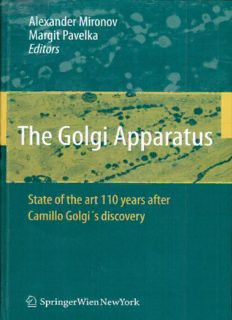
The Golgi Apparatus: State of the art 110 years after Camillo Golgi's discovery PDF
Preview The Golgi Apparatus: State of the art 110 years after Camillo Golgi's discovery
kroYweNneiWregnirpS Alexander A.MironovandMargit Pavelka(eds.) The Golgi Apparatus State of the art 110 years after Camillo Golgis discovery SpringerWienNewYork Prof. Dr. Alexander A. Mironov ConsorzioMarioNegriSud LaboratoryofIntracellularTraffic DepartmentofCellBiologyandOncology, S.MariaImbaro(Chieti),Italy Prof. Dr. Margit Pavelka DepartmentofCellBiologyandUltrastructureResearch InstituteofHistologyandEmbryology CenterforAnatomyandCellBiology MedicalUniversityofVienna Vienna,Austria GedrucktmitUnterstu€tzungdesBundesministeriumsfu€rWissenschaftundForschung inWien Thisworkissubjecttocopyright. All rights are reserved, whether the whole or part of the material is con- cerned, specifically those of translation, reprinting, re-use of illustrations, broadcasting,reproductionbyphotocopyingmachinesorsimilarmeans,and storageindatabanks. ProductLiability:Thepublishercangivenoguaranteeforalltheinformation containedinthisbook.Thisdoesalsorefertoinformationaboutdrugdosage and application thereof. In every individual case the respective user must checkitsaccuracybyconsultingotherpharmaceuticalliterature.Theuseof registerednames,trademarks,etc.inthispublicationdoesnotimply,evenin theabsence ofaspecificstatement, thatsuch namesareexempt fromthe relevantprotectivelawsandregulationsandthereforefreeforgeneraluse. (cid:2)2008Springer-Verlag/Wien PrintedinAustria SpringerWienNewYorkisapartof SpringerScienceþBusinessMedia springer.at Typesetting:ThomsonPress(India)Ltd.,Chennai Printing:HolzhausenDruck&Medien,1140Wien Printedonacid-freeandchlorine-freebleachedpaper SPIN:12054541 With106partlycolouredfigures LibraryofCongressControlNumber:2008932528 ISBN978-3-211-76309-4 SpringerWienNewYork Preface * V Preface In 2008, we celebrate the 110th anniversary of the first description of the complexapparatoreticolareinternobyCamilloGolgiintheBollettinodella Societa(cid:2) Medico-ChirurgicadiPavia.ThebiographyofCamilloGolgi,andthe GolgiapparatushistoryhaveimpressivelybeendescribedbyPaoloMazzarello in his book The Hidden Structure. A Scientific Biography of Camillo Golgi (OxfordUniversityPress,1999).Duringthe20thcentury,CamilloGolgisdiscov- ery hadachangingupanddownanduphistory,timelybeingassessedasan artefact,andthenagaincomingintothecentrestageofcellbiologicresearch. Today,itiswellestablishedthattheGolgiapparatusconstitutesamaincross- roadsintheintracellulartransportroutesofthebiosynthetic,endocytic,and recyclingsystems.Duringthepastdecades,multiplenewdiscoveriescontribut- edtotheunderstandingoftheorganizationandthefunctionsofthecomplex organelle(seeChapter1.1).In1997,theexcellentbookabouttheGolgiap- paratuseditedbyJ.RothandE.Bergerprovidedacomprehensivesummariz- ingpresentationofthestateofresearch100yearsafterthefirstdescriptionof theorganelle.Now,afterfurther10years,itisnecessarytosummarizeagain whatitisknownaboutthecomplexorganizationofCamilloGolgisapparatus. Ourbookisanattempttobringtogethermultiplenewresultsobtainedby differenttechniques,andaddressingdifferentaspectsoftheGolgiapparatus andintracellulartransport.Wearehopefulthatthepresentationofthestate oftheart110yearsafterCamilloGolgisdiscoveryofthecomplexapparato reticolareinternowillleadtoanimprovedunderstanding,novelinsights,and newperspectivesforfutureresearch. Acknowledgements The editors cordially thank all authors of the Chapters, all our colleagues involvedintheworkspresentedintheChaptersofthisbookwrittenbyusand byothers.WethanktheSpringerCompanyforthepossibilitytopublishthis book and in particular we thank Mag. Franziska Brugger, Mag. Angelika Heller,andMrs.UrsulaSzorgerforahugehelpinourwork.A.M.isespecially thankfultoDr.A.FusellaandD.Gaindomenicoforthetechnicalhelpandto ChrisBerrieandRamanParashuramanforcriticalreadingofthemanuscripts, inwhichA.M.isaco-author. A.A.MironovandM.Pavelka S.MariaImbaro/Vienna,May2008 Moviescanbeviewedonlineat: www.springer.com/springerwiennewyork/lifeþsciences/book/978-3-211-76309-4 Contents * VII Contents Introduction ............................................... 1 1. Generalconsiderations .................................... 5 1.1. TheGolgiapparatusandmaindiscoveries inthefieldof intracellulartransport................................ 7 1.2. TheGolgiapparatusasacrossroadsinintracellulartraffic... 16 2. MainmachineriesoperatingattheGolgiapparatus ............. 41 2.1. SNAREs............................................ 43 2.2. Rabs.............................................. 66 2.3. COPII ............................................. 78 2.4. COPI:mechanismsandtransportroles................... 87 2.5. ArfsandArls:modelsforArffamilymembersin membranetrafficattheGolgi .........................106 2.6. COGcomplex.......................................120 2.7. TheTRAPPcomplex..................................130 2.8. TheroleofCa2þintheregulationofintracellular transport ..........................................143 2.9. Golgiglycosylationenzymes...........................161 2.10. NucleotidesugartransportersoftheGolgiapparatus.......190 2.11. Luminallectins......................................207 2.12. TheGolgiribbonandthefunctionofthegolgins..........223 2.13. Functionalcrosstalkbetweenmembranetrafficking andcellsignalling...................................247 2.14. Theroleofthecytoskeletoninthestructureandfunction oftheGolgiapparatus ...............................270 2.15. Thedynamin–cortactincomplexasamediatorofvesicle formationatthetrans-Golginetwork ...................301 2.16. Thegeometryoforganellesofthesecretorypathway ......314 3. Maintransportsteps ......................................331 3.1. ER-to-Golgitransport ................................333 3.2. Intra-Golgitransport.................................342 3.3. Structureanddomainorganizationofthe trans-Golginetwork .................................358 3.4. Golgi-to-PMtransport................................375 3.5. Proteintransportfromthetrans-Golginetwork toendosomes ......................................388 VIII * Contents 3.6. Thetransportofsolublelysosomalhydrolases fromthe Golgicomplextolysosomes ...........................402 3.7. Transportoflysosomalmembraneproteins from theGolgicomplextolysosomes........................414 3.8. Retrogradeendosome-to-TGNtransport .................425 3.9. Retrogradeplasmamembrane-to-Golgiapparatus transport ..........................................459 3.10. Interactionsbetweenendocytosis andsecretorytransport ..475 3.11. Originsoftheregulatedsecretorypathway ..............485 3.12. Secretionandendocytosisinendothelialcells.............520 3.13. Formationofmucingranules..........................535 3.14. Golgiapparatusandepithelialcellpolarity...............563 3.15. Golgiapparatusinheritance...........................580 4. Peculiaritiesofintracellulartransportindifferentorganisms ......609 4.1. FeaturesoftheplantGolgiapparatus...................611 4.2. YeastGolgiapparatus................................623 4.3. MorphodynamicsoftheyeastGolgiapparatus............630 4.4. StructureandfunctionoftheGolgiorganelle inparasiticprotists ..................................647 4.5. EvolutionoftheGolgicomplex ........................675 5. Generalconclusions.......................................693 Contributorsinalphabeticalorder..............................697 Index.....................................................706 Introduction * 1 Introduction AlexanderA.MironovandMargitPavelka Allcellssecreteadiversityofmacromoleculestomodifytheirenvironmentor toprotectthemselves.Ontheotherhand,thereisthenecessitytoreplace membrane proteins and lipids that are being constantly degraded in com- partments of the secretory and endocytic pathways. Therefore, eukaryotic cells synthesize proteins for either export (secretion) or delivery to the secretory and endocytic compartments and to the plasma membrane (PM) forreplacementofdegradedproteinsandlipids.Thesynthesisiscarriedout byribosomesattachedtothecytosolicsurfaceoftheendoplasmicreticulum (ER).Thesynthesisofmostofcellularlipidsandallfattyacidsalsooccursinthe smoothER.Duringorafterthesynthesis,thepolypeptidechainscontaining transmembranedomainscomposedofhydrophobicaminoacidsareinserted intotheERmembrane,whereassolubleproteinsaretransferredintotheER lumen.Afterthecleavageoftheirleadinghydrophobicsignalpeptidesand afterproteinfoldingboththegroupsofproteinsaretransportedalongthe secretorypathway. TheGolgiapparatus(GA)isthecentralstationalongthispathway.While passingthrough theGA,proteinsandlipids undergo posttranslational mod- ifications (mainly glycosylation by Golgi glycosidases and transferases) and sorting.ThetransportofproteinsandlipidsfromtheERtotheirdestinations maybecarriedoutinseveralways:viathedissociationmechanism,thepro- gressionmechanism,and/orthelateraldiffusionmechanism(seeChapter1.2). Overthepast30years,thefieldofintracellulartraffichasseentremendous advancestowardstheidentificationoftherelevantmolecularmachineries. Substantialprogressintheisolation,cloning,andcharacterizationofproteins involvedinintracellulartransportanditsregulation,aswellasindeciphering correspondingmoleculareventswasachieved.Proteinsinvolvedinbudding, fission,fusion,andsortinghavebeendiscovered,and,insomecases,apicture ofhowsuchproteinsareassembledandworkhasbeenglimpsed.Incontrast, perhaps surprisingly, a satisfactory understanding of how transport occurs invivoattheorganellelevelhasnotbeenachieved,andthegeneralpicture ofthisprocessremainsobscure.Asaconsequence,ourpresentviewofthe overallmodeofintracellulartraffic(thephysiologyoftraffic)inlivingcells isratherpoorlydeveloped.Althoughinvitroreconstitutionexperimentshave beencrucialinestablishingtheminimumnumberofcomponentsrequired forcarrierbuddingusingbiochemicaltechniques,amorecriticalevaluation ofintracellulartransportcouldbecomplementedbyinvivoexperiments. Thereasonsforthislagarebothtechnologicalandconceptual.Techno- logical,becauseintracellulartrafficisanessentiallydynamiceventintimeand 2 * A.A.MironovandM.Pavelka space.Yet,methodstostudyitsdynamicfeatureshavebeenlackinguntilvery recently.Therecentadventofgreenfluorescentprotein(GFP)technologyhas nowpartiallyfilledthisgap.Conceptual,becausethefieldhasbeendomi- nateduntilveryrecentlybythemodelofintracellulartrafficbyanterograde vesicles.Thevesicularschemehasbeenverysuccessfulinprovidingaframe- worktointegrateanenormousamountofbiochemicalandgeneticevidence collectedoverthepasttwodecadesintoacoherentpicture. Inthepastyears,theprogressindevelopmentofnewscientificmethods accelerated. New microscopic and biochemical methods, new scientific in- strumentstogetherwiththedevelopmentofmoleculartoolshasgiventhe possibilitytostudybiochemicalreactionsandmoleculesinsinglecellswitha resolutionimpossibletoachievebefore.Significantprogresswasmadeinthe development ofnewsynchronization protocols suitable forstudy oftrans- portofseveralcargoes. Ontheotherhand,thecompletedecipheringofthefullgeneticcodeof yeast,humans,plantsandseveralotherspeciestogetherwiththedevelop- ment of proteomics provided a significant number of new proteins and details on protein–protein and protein–lipid interactions involved into the traffic. In the literature, there are thousands of details regarding protein interactions, their sorting signals, and the effects of their inhibition and deletion.Assuch,itseemsthatthefieldofintracellulartransportappearsto befacingaseriouscrisis.Therearenowsomanyproteinsandinter-protein interactions involved that it has become almost impossible to follow and understandthemeaningofallofthesedetails. Themainideaofthisbookisthustocollectthefullrangeofexpertiseand to examine the problems from differentpoints of view andwith different approaches. Thisbookisdevotedtothemolecularmechanismsofmorpho-functional organizationoftheGAandsummarizesmostofnewdatarelatedtotheGA. Thebookisacollectionofchapterswrittenbydifferentgroupsandtherefore expressesdifferentviewsespeciallyonthemechanismsoftraffic. Thepossibilitytofollowtheevaluationoftheintracellulartransportfrom differentpointsofviewandonthebasisofdifferentexpertisescouldhelpto resolvethiscontradictioninthefield. There are several levels in the book. The main is the description of cell physiology with emphasison the physiology ofintracellular transport. The secondlevelisthepresentationofthemorphologyinwidetermincluding light microscopy, analysis of live cells and so on. Finally, there are several chaptersdevotedtothemolecularmechanismsinvolvedindifferentphysio- logicalprocessesrelatedtointracellulartransport.Inthisbook,wecouldnot excludecompletelysomedegreeofoverlapping.First,becausetheauthors have different opinions about models of transport, and the second, it was necessarytoillustratesomeideasfromdifferentpointsofview.Weapologize to colleagues, whose relevant work has not been mentioned because of spacelimitationsandfocusingonworkpublishedmostrecently. Introduction * 3 Inthefirstpartofthebooktherearetwochapters.Oneisanoverviewof thehistoryofthisfieldofcellbiology.Thesecondoneisamorpho-functional overview of the main steps of intracellular transport including functional organizationandarchitectureoftheGA. In the second part of the book, main machineries operating along the secretorypathwayarepresented.TheseincludeSNAREs,Rabs,COPII,COPI, ARFs,ARFGEFsandARLs,COG,TRAPP,dynaminandcortactin,Golgienzymes andsugartransporters,ERGIC-53,andotherluminallectins,GolginsandGolgi matrix proteins. Lipids and lipid signalling, as well as common signalling mechanismswillbeassessed.Additionally,theroleofcalciumandotherions intheregulationofintracellulartransport,andtheroleofthecytoskeletonin Golgifunctionwillbedescribed. In the third part of the book, different transport steps of intracellular transportwillbeevaluated,namely,ER-to-Golgitransport,intra-Golgitrans- port,Golgi-to-PMtransport,Golgi-to-endosometransport,transportoflyso- somal enzymes, retrograde endosome-to-TGN transport, and retrograde PM-to-Golgitransport.Mechanismsofregulatedsecretionwillbeexplained inaseparatechapterandinparticular,mechanismsinvolvedinformationof mucingranulesaredescribed.Interactionsbetweenendocytosisandsecre- torytransport,therelationshipbetweentheGAandcellpolarity,aswellas structure and domain organization of the trans-Golgi network, and the questions of GA formation and inheritance will be discussed in separate chapters. Finally, in the last part of the book the reader will find some aspects about the peculiarities of intracellular transport in different organisms: plants,yeast,andprotists.Aseparatechapterisdevotedtotheendomem- brane ultrastructure and dynamics in yeasts. Finally, the models of Golgi evolutionwillbediscussedinthefinalchapterofthispart. Thisbookisintendedforcellbiologistsandhistologists,whoworkwith students,andalsoforscientistsworkinginotherfieldsofbiologyaswellas forstudentsperse.Themostimportantitemforteachingistheunderstand- ing of not a single or several mechanisms but the comprehensive view uponthefulldramaofdevelopmentofscientificmodels.Thereadersshould understand the logic of model replacements. Therefore, the aim of the bookistomakethefieldofintracellulartransportmoreunderstandableby keepingitassimpleaspossible,butalsoasfullaspossible,andatminimalcost. Finally,wewouldliketomentionthequestionofterminology.Sincethe originaltermwasGolgiapparatus,thistermisusedinmostofthechapters. However, both terms, Golgi apparatus and Golgi complex, are customary today.
Description: